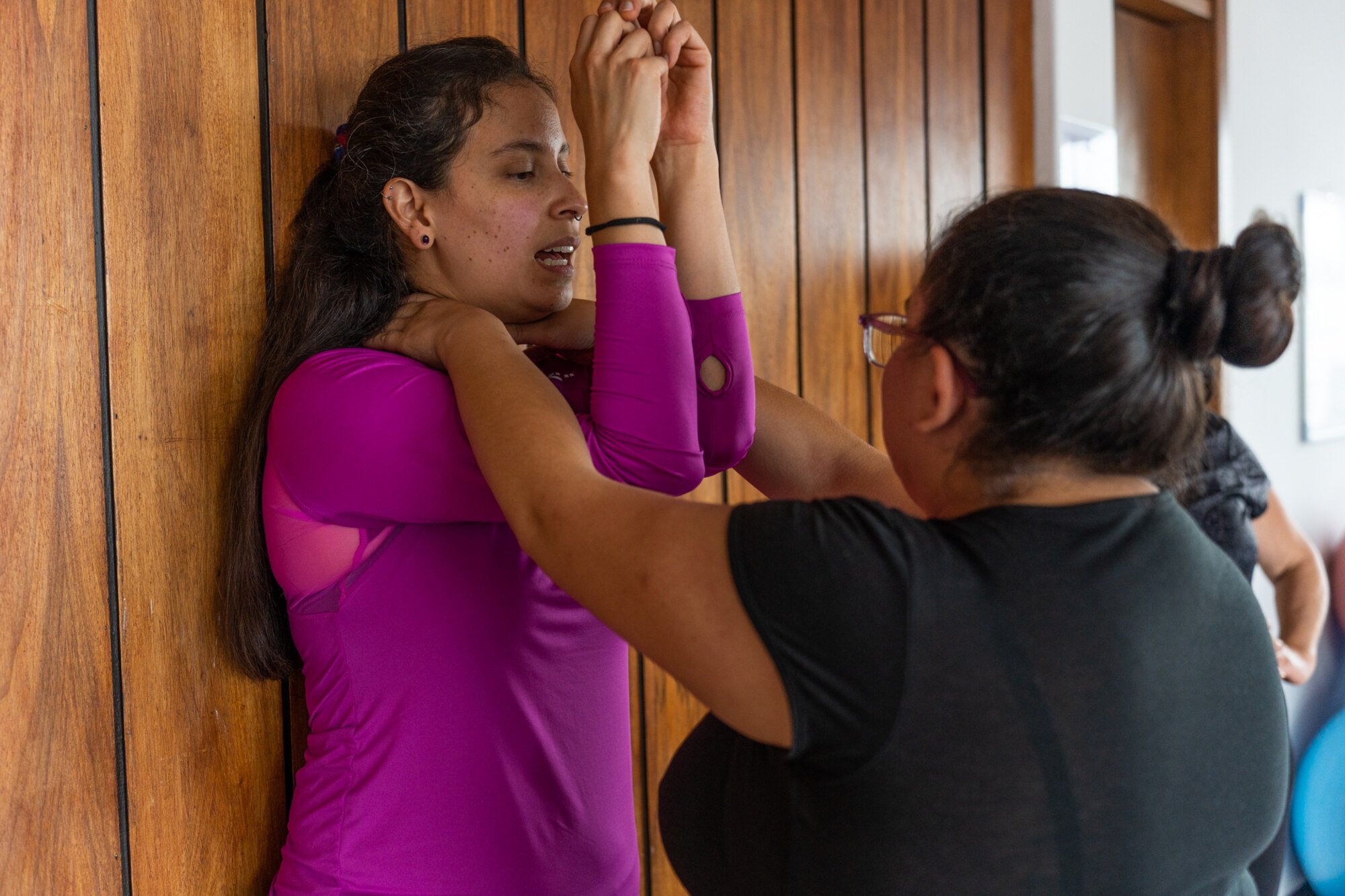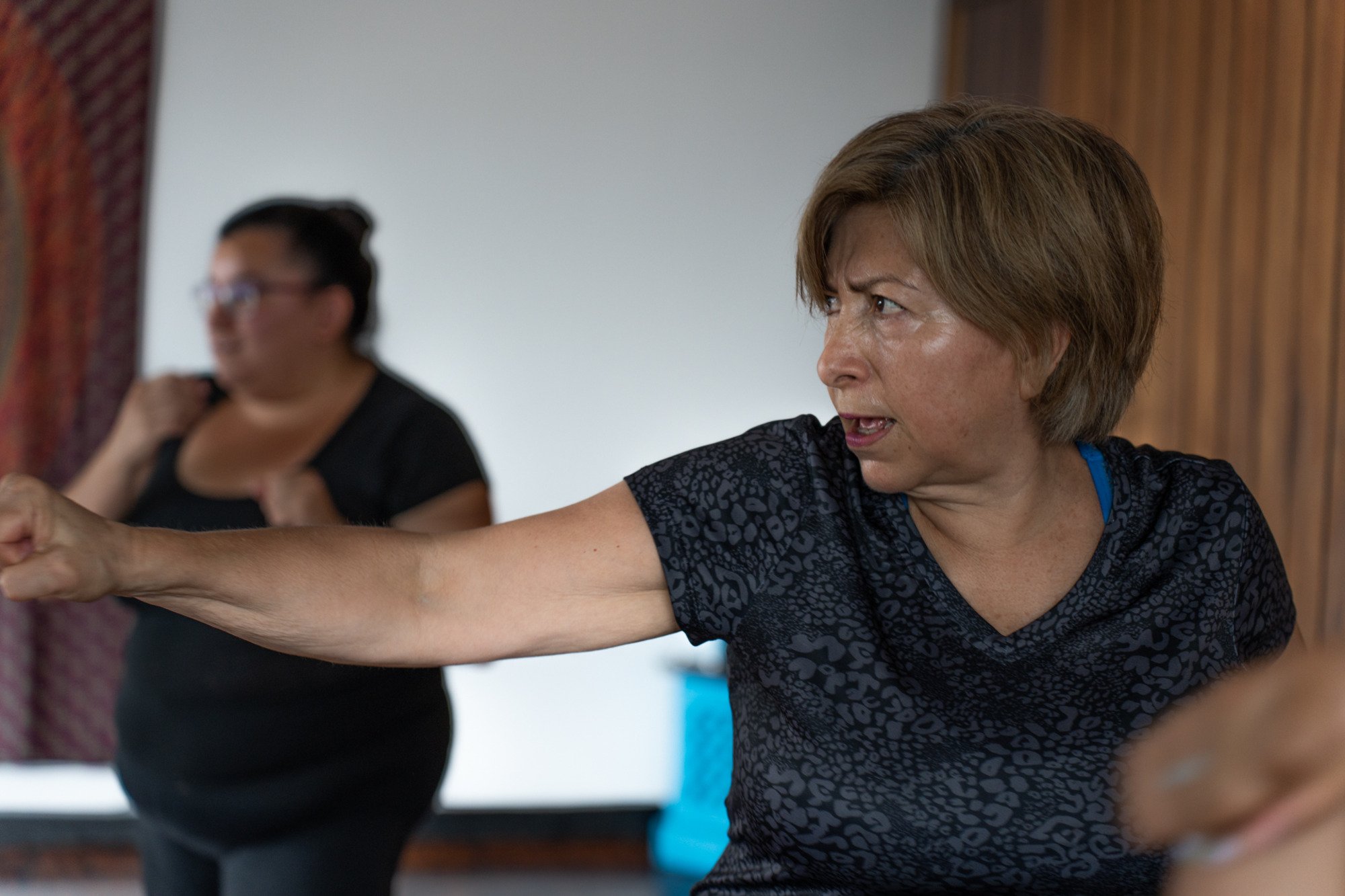Self-defense and strength in Ecuador
Ibeth Orellana Naranjo practices destabilizing her opponent and takes down her Muay Thai instructor, Johana Montesdeoca. Quito, Ecuador, January 9, 2024. Photo: Kimberley Brown.
Reportage • Kimberley Brown • February 7, 2024 • Leer en castellano
In a dojo in central Quito, Ecuador, Ibeth Orellana Naranjo is learning how to throw punches, kicks and knock her opponent off balance. She has been taking private Muay Thai classes since November and already feels stronger.
“I’m more confident in my body and ability to move. I realize that I won’t break if I fall, whereas before I felt fragile,” Orellana told Ojalá after a Tuesday morning class. “Now I know that I can throw a punch and my hand won't fracture. And I can get pushed and nothing will happen,” she added, as she wiped the sweat from her brow.
Orellana’s increased confidence is a common feeling among women who take self defense, according to her instructor Johanna Montesdeoca, who has been training women at the Kamikaze Hanuman’s Style school in Quito for the past two years.
Montesdeoca has seen more and more women get involved as they look for ways to empower themselves. She trains an average of 12 women each week, which would have been unheard of when she joined the school five years ago and was the only woman in the class.
Women sign up for self-defense courses for different reasons, says Montesdeoca, either for exercise, because of fear linked to the growing violence in the country or because of physical aggressions by a partner.
“I have seen a lot of successful cases in which women become stronger, not only physically but also mentally,” said Montesdeoca in an interview before class, as we waited for Orellana to arrive. “That’s what really matters: intellectual empowerment and increased self-esteem.”
Four self-defense and martial arts instructors in Quito told Ojalá that the number of women participating in their courses has risen steadily over the years as women look for new ways to defend themselves in a society where violence is increasingly common.
Robberies, assaults and violent crime have spiked across Ecuador in recent years. The small Andean nation is now considered one of the most dangerous in the region. Last year was also one of the deadliest for women in Ecuador. Over 277 women were victims of femicides, according to the Latin American Association for Alternative Development (ALDEA, in its Spanish acronym), which is based in Quito. A 2022 Gallup poll found that 72 percent of women in Ecuador say that they feel unsafe walking the streets alone.
The government blames rising crime rates on armed groups taking control of territory and the cocaine trade. Center-right President Daniel Noboa, who took office in November, declared an “internal armed conflict” in January. The decree defines 22 armed groups operating in the country as terrorist organizations, which allows the military to increase its use of force against them.
Violence and the state
Montesdeoca says that dojos across the city saw a boom in women’s participation in their classes in 2022 after the high-profile murder of Maria Belen Bernal, a criminal lawyer. Germán Cáceres, her policeman husband, strangled her to death in his dorm room on police grounds, before burying her body on a nearby mountainside and fleeing. Bernal’s killing shocked the country, as many wondered how it could be possible that no one heard shouts, calls for help, or saw him remove her body in a place that is surrounded by police.
“The state made it clear that it cannot protect women's lives,” said Nicoletta Marinelli, ALDEA communications officer. “So, in this situation, what do you have left? I think what’s left is personal self-defense.”
ALDEA has been tracking femicides in Ecuador since 2017 with the help of organizations across the country. They began keeping their own tally when it became apparent that the government wasn’t tracking the numbers. In their first year, they reported that one woman was a victim of femicide every 72 hours and, according to Marinelli, that number rose to one every 26 hours in 2023.
Part of the explanation for this increase, she says, was the spike in femicides during the pandemic, which has not subsided. But Marinelli thinks that the increase in criminal violence in the country has also played a role.
“When there is an [armed] conflict, women’s bodies are used as the spoils of war. They are raped and threatened and turned into weapons,” said Marinelli by video call from her home in Quito. “And that’s what is happening here in Ecuador.”
Psychologist and self-defense instructor Laura Mauriela Ruiz shows women in her self-defense course how to escape when someone is strangling you, January 6, 2024. Photo: Kimberley Brown.
Mind and body
Research shows women’s self-defense training is an effective way to reduce violence against women. It also avoids repeating patterns of victim blaming baked into the criminal justice system. A 2020 study found simple training in verbal and physical self-defense tactics, assertiveness, and learning how to read the environment and identify possible perpetrators can increase women’s awareness of risk and their self-confidence, thus reducing attacks.
In a yoga studio across the city to the north, in the hills that overlook Quito’s business district, psychologist Laura Mariela Ruiz Márquez started a self-defense group for women after she noticed that her patients were consistently talking about the rising number of assaults and robberies.
“I started to question one thing as I listened,” said Ruiz in an interview before class in the La Ceiba yoga studio. “How do you live when you know you inhabit a violent territory? How do you deal with that?”
Some things can’t be resolved in therapy, she concluded, but rather need to be addressed in the body and through collective experience. Thirteen women showed up to her first class one year ago, which was enough to convince her to continue the monthly sessions, which are based on her past jiu jitsu training. But Ruiz is clear that her classes are not only about learning how to throw a punch. Women share their experiences and feelings, and a hug at the end of a class, which helps them build a sense of connection and to not feel so alone.
Jacqueline Acosta throwing punches at her first womens’ self-defense course, taught by psychologist Laura Mauriela Ruiz, January 6, 2024.
Natalie Maya, who is 32, has been to seven of Ruiz’s monthly classes, which she says make her feel physically and psychologically stronger. As a little girl, she says that she was taught to be quiet and submissive and not to explore the possibilities or strength of her own body. Today, she takes her four-year old daughter with her to Ruiz’s classes, hoping to teach her otherwise.
Jacqueline Acosta, who is 59, took Ruiz’s class for the first time in January.
“Exercise for defense is the most important thing to defend ourselves in these times,” Acosta told me after her first session. “You learn to put your shyness aside and that a group of women can empower and learn from one another.”




